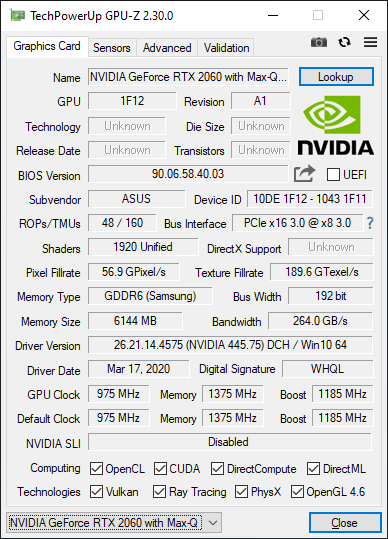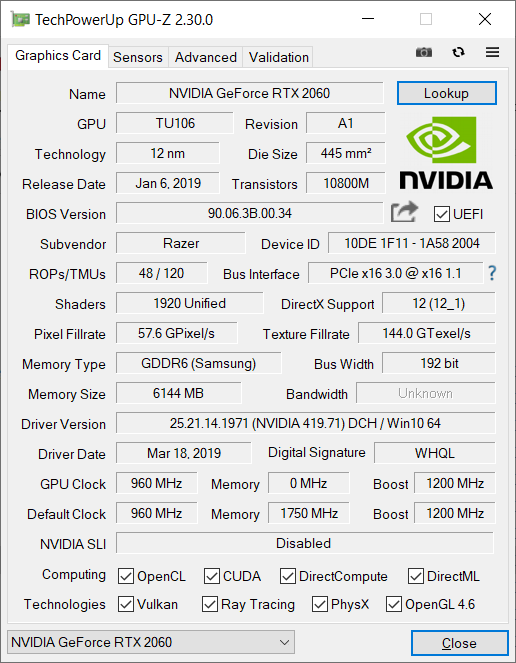AMD’s Mobile Revival: Redefining the Notebook Business with the Ryzen 9 4900HS (A Review)
by Dr. Ian Cutress on April 9, 2020 9:00 AM ESTGPU Benchmarks
Graphics is going to be a bit more challenging than the CPU tests. Games that test both the CPU and the GPU to the limits are going to find different tradeoffs with each of these systems.
The ASUS Zephyrus G14 is smaller and more thermally limited. It doesn’t have an AMD GPU, so it can’t take advantage of AMD’s new features like SmartShift that can manage power between the CPU and GPU. It technically has the stronger CPU, and while the graphics card is the same, ASUS has the Max-Q version of the RTX 2060, which is optimized for power and efficiency, and exhibits lower clocks. Technically the base frequency of this configuration is higher, at 975 MHz, the turbo is lower at 1185 MHz, and the GDDR6 memory is a lot lower at 1375 MHz (11Gbps/pin).
The Razer Blade 15 has the bigger chassis, and we assume is built for a larger overall TDP. While it has the ‘weaker’ CPU of the two, with fewer cores and lower frequency, it is paired with a full-fat GTX 2060 graphics card. We looked at the data for this card, and it exhibits a lower 960 MHz base frequency, it has the higher 1200 MHz turbo, 1750 MHz memory, and has a direct PCIe 3.0 x16 connection with the processor, while the ASUS system is only an x8.
For our tests, I’ve taken an older test (CS:Source), a couple of modern tests (Civ 6, FFXV) and a new test in Borderlands 3. We used the following settings:
- Final Fantasy, 1080p Fullscreen, Standard Quality
- Borderlands 3, 1080p, Medium Pre-Set
- Civilization 6, 1080p Maximum Preset No MSAA / 1K Occlusion Textures
- Civilization 6, 1080p Maximum Preset 8x MSAA / 2K Occlusion Textures
- Counter Strike Source, 1080p Maximum

In Final Fantasy, the results were around 10% different, favoring the AMD system.

Borderlands 3 was actually fairly close, with less than 5% between them, but still favoring AMD. I did notice that we were fairly close to the cutoff here between being CPU limited and GPU limited.

Civilization 6 is well known for constantly updating and being optimized, and here it seems the more powerful GPU wins out by a large 10 FPS margin.

However, if we add in some more compute and detail, we move to a more GPU limited scenario where the results are essentially equal.

Counter Strike is an odd one, given how old the game is. Here the game favors the Intel machine, with a ~10% advantage.
Like in the CPU tests, I did some of these gaming tests with the power cord removed and on battery saver mode. Results were interesting, to say the least, and can be found on the next page.












267 Comments
View All Comments
Dodozoid - Monday, April 13, 2020 - link
Yes, to the external one. Vega 8 gpu-z screen says pci-e 4.0 16x.realbabilu - Saturday, April 11, 2020 - link
I saw the absent of hdd 2.5 inch tray. Maybe it is why asus can have 14 inch form instead usual 15 inch form i7-9750H. The weight almost same with my cheap Msi 9RCX i7-9750H notebook around 1.6-1.7 kgs. Still 10H battery life and those raw power nailed it.oleyska - Saturday, April 11, 2020 - link
On the IGP page (first) you say L3 cache, it has bigger L2 cache and not L3 :)Also, what IF\Memory frequency does the 3950X run at in the latency test ?
Could it be compared at 1600 vs 1600 ? what if IF and memory is at 1800 ?
really good write-up!
Hrel - Saturday, April 11, 2020 - link
I wonder how much of this battery life gain that's being attributed to AMD is actually thanks to Nvidia. RTX 2060 shouldn't be compared to RTX 2060 MaxQ, that's pretty ridiculous. I'm willing to bet that's most of that extra 5 hours. Still, good on AMD, but why misrepresent it?SolarBear28 - Sunday, April 12, 2020 - link
You think 12 hours of battery life is possible using the discrete GPU? Its using the integrated vega graphics for the video playback and web battery tests.Santoval - Sunday, April 12, 2020 - link
It is extremely disappointing that a laptop of the caliber of Zephyrus G14 has a QLC based SSD. Who cares about the 1 TB of storage when as a trade-off you get piss-poor performance and the piss-poorest of endurance? QLC was originally employed in largely read intensive servers and now it shows up in SSDs for ... gaming laptops. Seriously Asus?Deicidium369 - Monday, April 13, 2020 - link
I have one of Samsung's first QLC drives, it has been used continuously since new, and has zero issues. Also have one the early OCZ 120GB drives - bought the day it dropped - has been used continuously since new - pulled it and reformatted it and tested - still 0 bad cells. So the whole endurance thing is WAY overblown...AntonErtl - Sunday, April 12, 2020 - link
Thank you for the review. A very good showing for the Ryzen 4xxxH series, now awaiting U reviews:-).There is one thing that I find disappointing: If I understand your review correctly, both memory controllers run at the same clock, so putting in a slower DIMM also slows down the soldered-in RAM. With the memory controllers and the infinity fabric clocks locked together, I should have expected that, but has AMD not loosened the lock recently? In any case, what I would love to see from laptops with partially soldered-in memory in the future would be that they soldered in LPDDR4x memory for better bandwidth (not sure if it saves power), and an independently clocked DDR4 DIMM. Maybe we will see it in Ryzen 5xxx APUs.
Curiousland - Sunday, April 12, 2020 - link
A general comment that most people missed the point -- Ryzen 4000 shows the potential of some optimization work on 7nm process as well as on the zen2 design and can improve when comparing the performance to the early version of zen2 on desktop ryzen 3000!This implies the further potential performance improve of zen3 ryzen 4000 can bring to the market even before they jump on TSMC 5nm for zen4.
Curiousland - Sunday, April 12, 2020 - link
I guess this is why Dr. Su said they are focusing on chip design architecture now more than rushing to next 5nm node. They must have seen plenty of potential of improvement along on 7nm for now already.